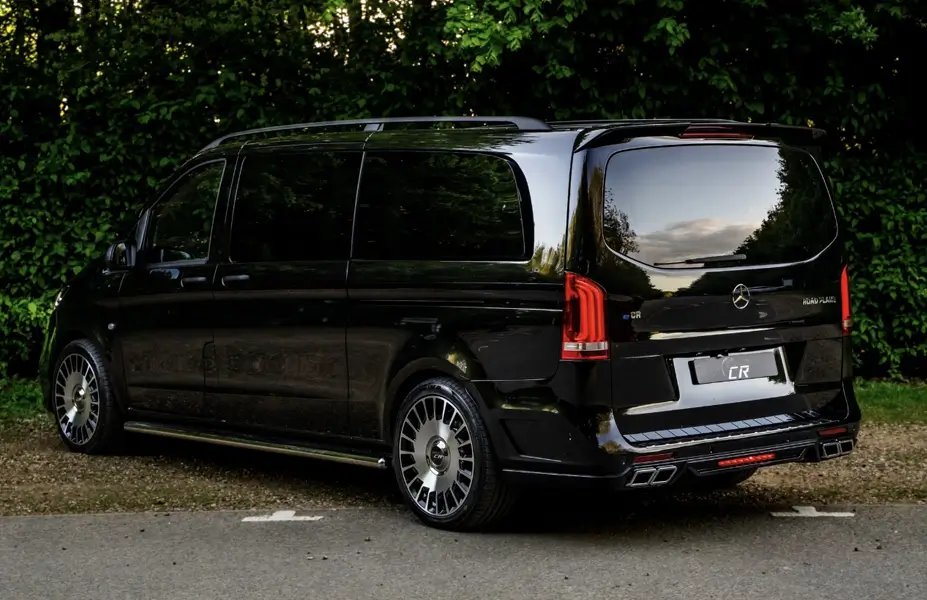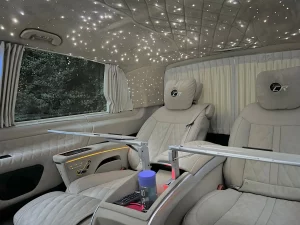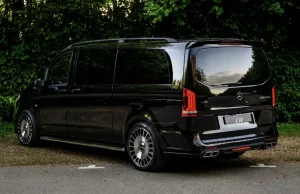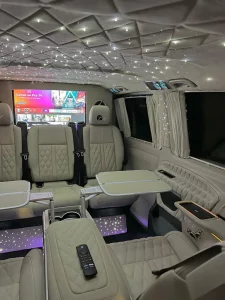When it comes to professional transportation, there are two main types of drivers: chauffeurs and drivers. While both operate vehicles, there are some key distinctions between the two roles.
A chauffeur is a driver who provides luxurious, personalised transportation services. Chauffeurs typically drive high-end vehicles like sedans, SUVs, or limousines.
A driver, on the other hand, primarily focuses on transporting passengers from one location to another in a safe, timely manner. Drivers can include those operating standard vehicles like taxicabs, rideshares, buses, or personal vehicles.
What Is a Chauffeur?
A chauffeur provides luxury transportation services through meticulous attention to both driving skills and exemplary customer care. Beyond ferrying passengers from point A to B, chauffeurs aim to deliver an experience characterised by elegance, comfort and tailored service.
When clients step into a chauffeur’s vehicle, they enter a world of personalised mobility. Skilled chauffeurs are there to assist passengers gracefully, carefully handle luggage and cater to every need – whether that’s providing bottled water on long trips or making restaurant recommendations at destinations.
Critical to their role is embodying traits like courtesy, calmness under pressure and discretion. Chauffeurs understand the importance of respecting customers’ privacy and being punctual to maintain their schedules. Punctuality, trustworthiness and professionalism are hallmarks of the job.
The responsibilities of a professional chauffeur also include maintaining vehicles to high standards. This ensures aerodynamic performance as well as meticulous cleanliness inside and out. Through attentive upkeep, chauffeurs preserve luxury vehicles for a continuous experience of sophistication and reliability.
In regard to qualifications, chauffeurs tend to have higher insurance premiums compared to regular drivers due to operating expensive vehicles transporting high-profile clients. This underscores their serious dedication to safety in roles demanding specialized skills.
So, a chauffeur surpasses mere driving to deliver an organized, elegant service through refined vehicles and exemplary conduct honed by comprehensive training.
What is a Driver?
A driver is an operator of passenger vehicles whose principal role is providing safe and reliable transportation for clients. Unlike chauffeurs, the focus of drivers lies primarily in transporting individuals from one destination to another upon request.
Compared to chauffeurs with specialised licenses, the qualifications required of drivers center upon acquiring a standard driver’s license that authorises operation of automobiles. To secure such a permit, candidates must pass a written examination on traffic rules as well as a road test evaluating basic maneuvers.
Once licensed, drivers may use their own vehicles or those belonging to transportation companies like taxi services, ride-hailing platforms or shuttle networks for hire. The vehicles employed cover a spectrum of economy cars to family-sized vehicles better suited to cost-effective mass transportation as opposed to luxury.
While reliable mobility remains a priority, the broader repertoire of services involved in chauffeuring is typically not emphasised in driver-based transportation. The aim is mainly point-to-point conveyance from pick-up to destination rather than bespoke assistance catered around passengers’ specific preferences.

Differences Between a Chauffeur and Driver
There are several notable distinctions between the roles of a professional chauffeur and regular driver. Let’s examine these key variances in dress code, role and responsibilities, qualifications and training, vehicle type and more.
Dress Code
A chauffeur emphasises elegance through their attire, typically wearing a sharply tailored suit, polished shoes and accessories like a hat or gloves for a sophisticated appearance. In contrast, drivers are less formal – sometimes sporting casual jeans, shorts or t-shirts depending on company policy or weather conditions. Maintaining an impeccable, well-groomed image in proper uniform is critical for chauffeurs to complement luxury vehicles and services.
Role and Responsibilities
While transporting clients remains central for both, chauffeurs shoulder wider responsibilities through specialised customer service. Drivers focus primarily on safely operating vehicles from pickup to destination. Chauffeurs go beyond by meticulously maintaining the condition of high-end cars, planning optimal routes according to traffic and carefully attending to passenger needs. They exceed expectations through services ranging from luggage handling and opening doors to providing recommendations for dining or attractions en route.
Qualifications and Training
Acquiring a standard driver’s license qualified individuals for driving jobs. However, chauffeurs undergo intensive defensive driving courses, first aid seminars and role-specific training covering topics such as vehicle protocol, customer etiquette and local geography. Their comprehensive preparation emphasises safety, refined conduct and empowerment to skillfully resolve issues. Some companies require drug tests and verifications of applicants’ driving records to uphold professionalism standards.
Vehicle Type
Taxi drivers, shuttle operators and personal conveyance services commonly rely on affordable, mass-produced vehicles prioritising functionality over luxury. Chauffeurs instead drive carefully maintained luxury models incorporating premium sound systems, plush seating and onboard amenities. Brands like Mercedes, Cadillac and Range Rover ensure passengers experience unparalleled comfort while benefiting from features like mini-bars, climate control and WiFi connectivity.
So, the role of chauffeur surpasses basic transportation responsibilities through specialised qualifications, higher expertise demands and association with high-end vehicle fleets. Their meticulous training equips refined conduct balancing courteous service with security awareness. Uniform codes and appearance standards complement elegant vehicles in providing impeccable journeys.
Meanwhile, drivers focus primarily on safely moving clients as opposed to customised service or operation of top-tier automobiles. Determining whether luxury, experience or practicality suit goals best indicates whether chauffeur or driver services better satisfy unique transportation needs.
When to Hire a Driver
While chauffeurs are suited for special occasions demanding luxury, a driver is preferable for more everyday activities not necessarily requiring their elevated service standards. Some suitable scenarios encompassing a driver’s customary functionality include:
Everyday Commutes
For routine transportation duties like commuting to work or shuffling children between after-school classes, a driver provides a practical solution. Their no-frills approach works well for repetitive short-distance trips where formality isn’t crucial.
Errands and Appointments
Running errands like going to the bank, pharmacy or dry cleaners are reasonable use cases for drivers given multiple stops. Their versatility in multi-tasking caters to busy personal schedules with convenience.
Casual Events
Family gatherings, informal get-togethers with friends or running kids to recreational games are scenarios where a driver’s informal transportation aligns with casual atmospheres. Their amenity-lite vehicles suit trips where luxury isn’t a top priority.
Opting for drivers is cost-effective in such day-to-day situations compared to chauffeur services. Their accessibility through taxicabs or rideshare apps also provides spontaneous on-demand rides as needed.
When to Hire a Chauffeur
While drivers suffice for everyday tasks, special occasions, airport transfers, VIP transportation, corporate meetings, wedding, prom and high-profile events call for a sophisticated service of a professional chauffeur.
Special Occasions
Moments like anniversaries, milestone birthdays or formal celebrations warrant premier transportation through quality vehicles and bespoke assistance reflective of the importance.
Airport Transfers
Manicured arrivals and departures paired with relaxed journeys throughout airports are ideal for easing travel stresses, especially on professional trips.
VIP Transportation
Celebrities, foreign dignitaries and high-net-worth individuals rely on chauffeurs for secure, discreet mobility allowing undisturbed productivity.
Corporate Meetings
Executives require punctual transportation, allowing preparation en route to boardroom presentations flawlessly dressed and composed.
Weddings
Luxurious sedan arrivals or spacious limousines emerge as standard for complementing brides’ grand entrances and seamless ceremonies.
Prom
Corsages and boutonnieres stay pristine owing to chauffeurs carefully transporting couples photoshoot-ready in high-end rentals creating lasting memories.
Chauffeurs leave reliable impressions through impeccably maintained premium vehicles, polished customer service, discretion and expertise navigating urban landscapes. Their comprehensive skills best match circumstances demanding theatrical red-carpet treatment.
Conclusion
Both chauffeurs and drivers fill important roles in professional transportation. Chauffeurs surpass simple driving to immerse clients in refined luxury through specialised preparation and association with high-end automobiles. While drivers focus primarily on cost-effective mobility from point A to B, they enable pragmatic solutions for everyday tasks. Determining needs around formality, budget and intended atmospherics helps distinguish whether premium chauffeur standards or driver accessibility is preferable for various occasions. Overall, the industry benefits from distinct yet complementary roles supporting diverse travel requirements.







